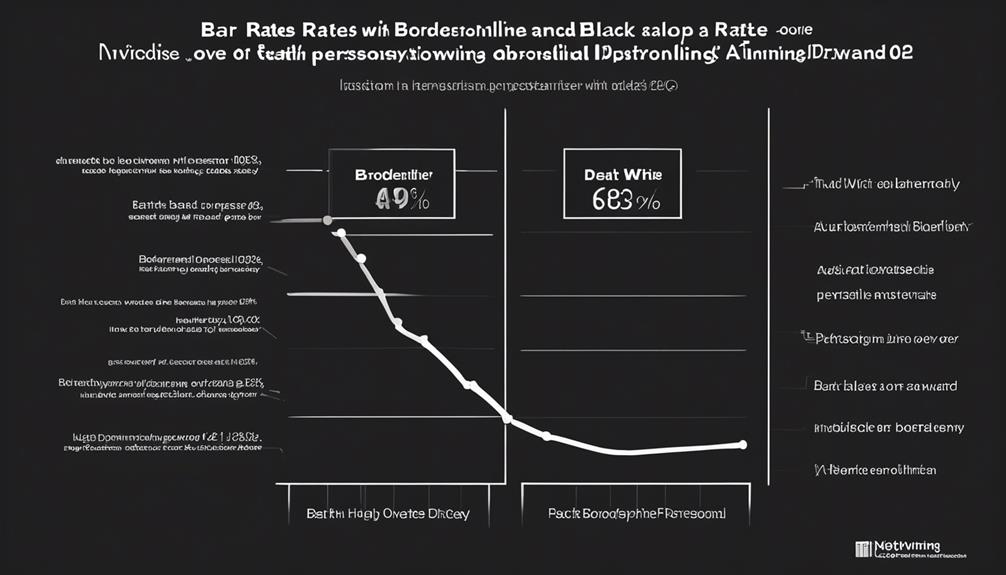When both partners in a relationship have Borderline Personality Disorder (BPD), it can feel like trying to navigate unpredictable waters with turbulent waves.
The complexities that arise when two individuals with BPD come together create a unique tapestry of emotions and challenges that demand attention and understanding.
As we delve into the intricacies of dual BPD dynamics, we uncover the nuances of shared intensity, communication struggles, and the importance of building a supportive framework that fosters growth and stability.
Challenges of Dual BPD Dynamics
In navigating the challenges of dual BPD dynamics within a relationship, emotional intensity and frequent conflicts often arise due to symptoms such as insecurity and emotional dysregulation. Both partners may grapple with low self-esteem, fear of abandonment, and struggles in managing intense emotions in a dual BPD dynamic. These factors can create a turbulent environment where misunderstandings and clashes are common.
To address these challenges, open communication plays a crucial role. Discussing needs and boundaries openly can help prevent misunderstandings and foster healthier interactions in relationships with dual BPD dynamics. Setting clear boundaries is essential to establish a sense of security and predictability within the relationship. Prioritizing self-care is equally important to ensure both partners are in a better position to manage their emotions and navigate the complexities of dual BPD dynamics.
Communication Struggles and Solutions

Navigating communication struggles in a relationship characterized by two individuals with BPD involves addressing heightened emotional intensity and fear of abandonment, which often lead to conflicts and breakdowns in understanding. Misunderstandings, stemming from hypersensitivity to negative emotions, can escalate conflicts and hinder effective communication.
To improve communication in such relationships, setting clear boundaries is crucial. Practicing active listening can help validate each other's feelings and promote mutual understanding. Open and honest communication plays a vital role in building trust and fostering empathy between partners.
Employing strategies like using 'I' statements, maintaining patience, and showing empathy can enhance communication and facilitate conflict resolution. By actively engaging in these practices, individuals in a relationship characterized by BPD can work towards creating a more harmonious and understanding dynamic, where both partners feel heard and valued.
Impact of Shared Intensity
The shared intensity experienced in a relationship involving two individuals with BPD often magnifies emotional experiences, leading to heightened conflicts and challenges in emotional regulation. When both partners struggle to regulate their intense emotions, misunderstandings and conflicts can arise frequently, creating a tumultuous dynamic.
The amplified fears of abandonment within the relationship can trigger impulsive behaviors, further complicating the situation. Additionally, the shared emotional intensity may contribute to a cycle of idealization and devaluation between the partners, where perceptions of each other fluctuate dramatically.
To manage the impact of this shared intensity, developing coping strategies and enhancing communication skills are essential. Seeking professional help can also provide valuable guidance in navigating the complexities that arise. By acknowledging the challenges posed by the shared intensity amplification, both individuals can work towards building a more stable and fulfilling relationship.
It's crucial for both partners to proactively address these issues to foster a healthier and more sustainable connection.
Navigating Triggers and Conflict

Shared triggers and conflicts in a relationship involving two individuals with BPD often stem from intense emotional reactions and struggles with emotional regulation, exacerbating challenges in communication and emotional responses.
Fear of abandonment, rejection, or perceived criticism can act as potent triggers, leading to conflicts that may spiral due to hypersensitivity and communication breakdowns. In such situations, self-soothing techniques become crucial to prevent heightened emotional responses.
Setting clear boundaries can aid in managing conflicts and reducing misunderstandings. Seeking professional help, such as therapy or counseling, can offer valuable strategies for navigating triggers and conflicts effectively.
Building a Supportive Relationship
Establishing open and honest communication is foundational for nurturing a supportive relationship between two individuals with BPD. Prioritizing self-care and setting clear boundaries are essential for managing insecurities, emotional regulation difficulties, and intense attachment within the relationship. Seeking therapy or counseling can aid in developing coping skills, enhancing emotional regulation, and strengthening the bond between two individuals with BPD. It is crucial to practice active listening, empathy, and patience to understand each other's perspectives and needs in the relationship. Utilizing mindfulness practices and effective communication strategies can foster trust, mutual support, and emotional stability in a relationship with two individuals with BPD.
| Key Strategies | Description |
|---|---|
| Prioritize Self-Care | Focus on individual well-being to better support each other emotionally and maintain personal boundaries. |
| Seek Therapy | Professional guidance can help develop coping mechanisms, improve emotional regulation, and enhance the relationship. |
| Practice Mindfulness | Being present in the moment can promote understanding, empathy, and emotional stability within the relationship. |
| Establish Boundaries | Clearly defining personal limits can prevent conflicts and manage intense emotions effectively. |
Frequently Asked Questions
Can 2 People With BPD Be in a Healthy Relationship?
Yes, two people with BPD can be in a healthy relationship. By actively managing symptoms, seeking therapy, and practicing effective communication, a stable and fulfilling partnership is achievable.
Setting boundaries, prioritizing self-care, and building trust are essential components for maintaining a positive relationship.
Embracing personal growth and mental health treatment can lead to a supportive and loving connection between individuals with BPD.
What Is the Best Partner for Someone With Bpd?
We find that the best partner for someone with BPD is understanding, patient, and willing to learn about BPD symptoms and triggers.
Open communication, clear boundaries, and consistent support are crucial for successful relationships with individuals with BPD.
Encouraging seeking professional help, prioritizing self-care, respecting needs, and showing empathy towards intense emotions can greatly benefit someone with BPD.
Mutual efforts in building trust, understanding triggers, and practicing effective communication contribute to a healthy relationship.
What Is the Trauma of Dating Someone With Bpd?
Dating someone with BPD can be like navigating a turbulent sea, where emotional storms can strike at any moment.
The trauma of such relationships often stems from the rollercoaster of intense emotions and fear of abandonment.
This experience can lead to a constant feeling of walking on eggshells and being responsible for managing their emotional turmoil.
Feeling invalidated and struggling to set boundaries can further compound the trauma of dating a person with BPD.
What to Do When Your BPD Partner Is Splitting on You?
When our BPD partner is splitting on us, we must practice empathy, validate their feelings, and avoid impulsive reactions. Setting clear boundaries and maintaining open communication can help navigate splitting episodes and prevent conflicts.
Understanding that splitting is a symptom of BPD and seeking support from therapists or support groups can assist in managing the challenges it presents in the relationship.
Conclusion
In conclusion, navigating a relationship with two individuals with Borderline Personality Disorder can feel like riding an emotional rollercoaster without a safety harness. But hey, who doesn't love a good adrenaline rush, right?
By prioritizing communication, self-care, and setting boundaries, we can turn this wild ride into a thrilling adventure of growth and understanding.
So buckle up, hold on tight, and enjoy the unpredictable journey of love and intensity with two BPD partners.
Val brings a wealth of knowledge and empathy to our team, crafting articles that touch the heart and enlighten the mind. As an expert writer, she dives deep into the subjects of BPD, offering informative and deeply relatable perspectives. Val’s contributions are instrumental in making complex psychological concepts accessible to our audience, helping to foster understanding and compassion.










